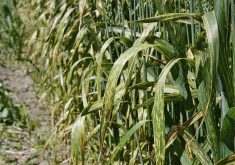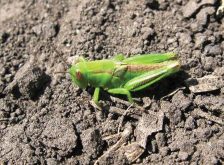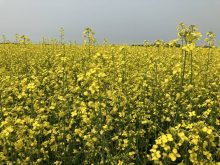A lot of flea beetles, few diseases and pretty good yields are highlights of this growing season for three crop specialists.
“In general, we’re at or above average for the five-year (yield) average and some of the 10-year averages,” said Jeremy Boychyn, agronomy research extension manager with Alberta Wheat and Alberta Barley. “All of Alberta was about 110 per cent of the five-year yield index.”
[RELATED] Scout your fields to keep on top of this year’s pest insects
Read Also

Mosquito-borne virus could be devastating to sheep breeding operations
Cache Valley virus, a mosquito-borne disease that infects small ruminants, could be a devastating hit to small operations.
Of course, averages are just that and areas that didn’t receive the timely June rains suffered.
“Those regions that received less rain in early June or July will be impacted because we had a lack of subsoil moisture,” noted Boychyn.
Earlier rains would have helped a lot in the south, where spring wheat, for example, averaged just 31.2 bushels per acre. Still, that’s far better than the 17.8 bushels-per-acre average in 2021. The jump was even more dramatic in central Alberta, where average yields were 63 bushels, more than double the average from a year earlier.
Quality was generally good; above average for hard red spring wheat, canola and dry peas and about average for malt and feed barley.
And there weren’t a lot of complaints come harvest time.
“There were not a lot of moisture holdups,” said Boychyn. “There were some fire concerns because of how dry it was. Some producers had to slow down due to excess heat and fire risk.”
Soil moisture is once again a concern.
“We need a good snowpack and conditions to get it melted. In addition to that, we need a good amount of spring rainfall, prior to and after seeding,” he said.
“We went into this spring very dry. We were lucky enough to get June rains. If we don’t get moisture in the spring, and we don’t get those June rains, it could cause us to have another 2021 season.”
[RELATED] Christmas came in June this year on most farms
A quiet year for disease
“We didn’t have any province-wide emergencies or epidemics,” said Mike Harding, plant pathologist with Alberta Agriculture and Irrigation.
“We didn’t really see any new or emerging pathogens that we have never seen before. There were cases where disease was extremely damaging and yield limiting, but on a very case-by-case basis.”
However, bacterial leaf streak and wheat streak mosaic virus made appearances in 2022, and Harding would like growers to watch for them.
“We’ve been talking about bacterial leaf streak for the past four to five years, but it continues to spread and continues to cause some real headaches for growers that have had it kind of run away from them in the field,” he said.

Bacterial leaf streak, which is caused by a bacterium, can be seed borne and can get splashed about with rain, and can move relatively long distances in a thunderstorm. The bacteria flourishes in warm, wet conditions, and populations can double in a day.
“The number of bacteria in a field where conditions are conducive can ramp up quickly,” said Harding. “The second problem is that we don’t have any good pre-season or in-season control tools to manage it.”
Lack of seed treatments, foliar sprays or genetically resistant varieties wasn’t a huge problem when the disease first showed up in Alberta in the 1930s or 1940s.
“In the past, bacterial leaf streak would show up in a field or two and be more of a curiosity than a problem. And then we wouldn’t see it again for a decade,” Harding said. That changed around 2017.
“We started seeing it in an increasing number of fields,” he said. “We started hearing about it in about 10 to 15 fields and now we’re probably up into the hundreds of fields. We’re seeing the worst of it in irrigated southern Alberta because that’s where the warm, wet conditions exist that cause the bacteria to multiply.”
Growers can find bacterial leaf spot at the flag leaf stage, or just ahead of flag leaf emergence. It will appear as elongated stripes that will turn yellow, and if there is humidity, there might be “bacterial ooze,” he said.
“There’s probably going to be growers who have never seen this or heard of this, who may have it show up,” said Harding. “You need to know what to look for and you need to watch for it, because in some cases, it’s going to look a lot like a leaf spot disease that we can treat with a fungicide.
“But a fungicide isn’t going to control it.”
Harding encourages growers to google the disease and study images.
He also warned about wheat streak mosaic, which shows up mainly in southern Alberta cereals. There is no control for this disease either.
“It’s important to watch for these ones that flare up once in a while, or emerge as the new kid on the block,” he said.
Beetles and hoppers
“If you follow anyone on Twitter, you’ll know that they battled them this spring really hard,” said Shelley Barkley, insect survey technologist with Alberta Agriculture and Irrigation.
Cruciferous and striped flea beetles were equally bad this year due to a combination of weather, stand establishment issues and a population that successfully overwintered.
[RELATED] Flea beetles: more species, more territory
Barkley said the beetles, which feed on canola, were bad across the province.
Grasshoppers were another problem.
“It’s not a surprise, because we had that beautiful fall last year,” she said. “The females were able to lay a lot of eggs and we had a lot of potential in the ground.”
Areas south of Calgary were among those with peak grasshopper activity. Diamondback moth larvae were at near threshold or at threshold from Vulcan to Olds.
“There was a fair bit of chemical put on for those guys,” said Barkley.
Insects that do better in drier conditions seem to be thriving. Wheat stem sawfly flourished in Vulcan County and on the south side of Kneehill County.
Barkley said grasshoppers may be a problem again next year in southern Alberta because of the mild fall. Flea beetles may not be a problem if the weather is good and canola emerges ahead of them.
“Producers just need to be prepared and be out scouting for flea beetles and for grasshoppers when they are out and about and starting to hatch in June,” she said.
Growers might also want to sign up for the Prairie Pest Monitoring email that alerts growers to problems. Population maps for all tracked insects will be posted on the Alberta Agriculture and Irrigation website, under the Alberta Pest Monitoring Network.
















